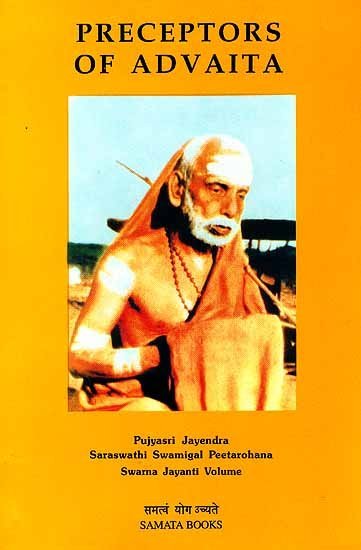Preceptors of Advaita
by T. M. P. Mahadevan | 1968 | 179,170 words | ISBN-13: 9788185208510
The Advaita tradition traces its inspiration to God Himself — as Śrīman-Nārāyaṇa or as Sadā-Śiva. The supreme Lord revealed the wisdom of Advaita to Brahma, the Creator, who in turn imparted it to Vasiṣṭha....
51. Ānandagiri
ANANDAGIRI
by
K. Balasubramania Sastri
Sāhitya-Mīmāṃsā-Vyākarana Śiromaṇi
Ānandagiri, otherwise known as Ānandajñāna, is an erudite commentator on Śrī Śaṅkara’s bhāṣyas on the Upaniṣads, the Bhagavad-gītā and the Brahma-sūtra. It is a matter of satisfaction that we are able to get some information about the author from his works themselves. In his Īśāvāsya-bhāṣya-ṭippaṇa, Ānandagiri says that the pariṇāma-vāda of Bhāskara has been rejected by him in his Tattvāloka.
bhāskarābhimataḥ pariṇāma-vādaḥ tattvālokē nirasta eva asmābhiḥ.[1]
Again in his Taittirīya-bhāṣya-ṭippaṇa he refers to Tattvāloka.[2]
From these we may conclude that Ānandagiri and Janārdana are identical And, Janārdana must have been Ānandagiri’s name in his previous stage of life (āśrama).
Apart from Tattvāloka, he wrote another work entitled Tarka-saṅgraha published in the Gaekwad Oriental series. It is a critical examination and a systematic refutation of the Vaiśeṣika system from the stand-point of the Advaita school. The Vaiśeṣika school has been the pioneer of all the dualistic philosophers. Ānandagiri himself in the Tarkasaṅgraha observes that this effort is to establish on the basis of reasoning and scripture the one without a second.
ekarasam hi vastu pramāṇato nyāyataścha pratipādayitum prayatnaḥ.[3]
And, at the end of this work he affirms that his arguments against the Vaiśeṣika school could very well be extended to the other schools of thought and it would be clear then that their theories and definitions of the categories accepted by them are false.
Following Chitsukha, the author of the Tattvapradīpikā, and Śrī Harsha, the author of the Khaṇḍana-khaṇḍa-khādya, Ānandagiri in his work Tarkasaṅgraha is mainly concerned with proving the non-real character of the phenomenal universe. It is one of the maxims of the Nyāya-Vaiśeṣika school that an object is real if it can be defined and proved. Ānandagiri, therefore, in order to prove that there is no reality apart from Brahman, takes up each and every object admitted by the Vaiśeṣikas for critical examination. He refutes all definitions of the Vaiśeṣika system intended to justify the reality of the categories of experience and shows that the world and all world-experiences are merely appearances and are indescribable either as real or unreal. Now, since all appearances must have something for their cause and since that which is not a real thing cannot have a real thing as its material cause, and since they are all indescribable in their nature, their cause must also be of that nature, the nescience of the substratum.
He then proceeds to point out that nescience which is the material cause of the universe is associated with Brahman, the pure consciousness. And, owing to its association with Brahman, Brahman appears as the all (sarva) and it becomes as the all-knower (sarvajña). Brahman could not be regarded as omniscient or the knower of all (sarvajña) without its association with nescience. Thus there is the one Brahman and there is one beginningless nescience in connection with it, which is the cause of all the infinitely diverse appearances through which the former appears impure and undergoes transmigration, as it were, and again appears liberated, as it were, through the direct experience of the real nature of the self. In fact there is neither bondage nor emancipation.
Ānandagiri refers to Khaṇḍana-khaṇḍa-khādya of Śrī-Harsha in his Taittirīya-bhāṣya-ṭippaṇa, Śrī-Harsha flourished in the latter half of the twelfth century. We may take Ānandagiri as having flourished in the beginning of the thirteenth century. At that time, the Nyāya-Vaiśeṣika school was active in opposing the jagan-mithyātva-vāda of Śrī śankara. By proving on the basis of reasoning that the universe is indescribable either as real or as unreal, he rendered a solid service to the cause of Advaita. His position as an interpreter of Śrī Śaṅkara’s philosophy is evident from the number of excellent commentaries which he wrote on the commentaries of Śrī Śaṅkara.
Footnotes and references:
[1]:
Ānandāśrama Edition, p. 15.
[2]:
Ibid., p. 6.
[3]:
Tarhasaṅgraha, Gaekwad Oriental series, p. 10.
